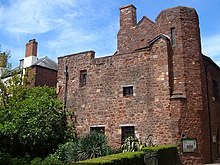Exeter monastery
Celtic Christianity was introduced to the area during the fifth century by Welsh, Irish and Breton missionaries[12] and a church and cemetery are thought to have existed on the site of the present Exeter Cathedral at this time.[13] The defeat of the British in 682 by King Centwine of Wessex allowed the Saxons to reach Exeter,[12] and in the late seventh century the church appears to have become a monastery under abbot Wulfhard.A monastic revival was encouraged by the king during his reign and he identified Exeter as a place suitable for monks to join the clergy.There is one building surviving from Polsloe Priory: the main part of the west range, built of the local red sandstone and believed to date from around 1320.The guest wing and a kitchen at its northern end were converted into an Elizabethan town house after dissolution, and this is now maintained as St Nicholas' Priory museum by Exeter City Council.
St Nicholas' Priory, ExeterMiddle AgesExeterEnglandBlessed Virgin MarySaint PeterbasilicaCathedral YardRoman bath houseJohn HokerconventÆthelred of WessexKing EdgarSweyn ForkbeardCanuteBenedictineÆthelstanChurch of St Mary Major, ExeterAugustinianCanonessesCathedral closeBenedictine Priory of St NicholasSt James PrioryCluniacPolsloe PrioryExeter BlackfriarsDominicanExeter GreyfriarsFranciscanCarthusianend of Roman rule in BritainPost-Roman periodRomano-BritishDumnoniaCeltic ChristianityExeter CathedralCentwine of WessexSaint Bonifaceminster churchBishop SidemanBishop of CreditonBishop LeofricBishop of Cornwallbishopricsepiscopal seeDissolution of the MonasteriesHenry VIIIExeter City CouncilList of monastic houses in DevonRichard John King